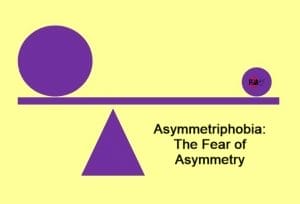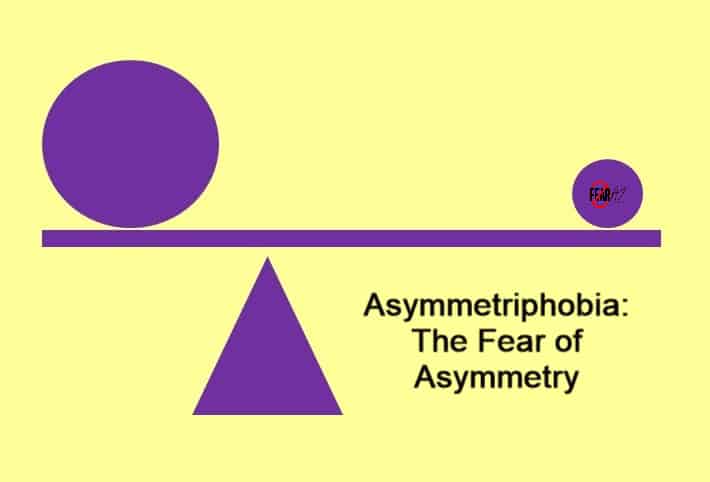Share This Article
What Is Asymmetriphobia or the Fear of Asymmetry?
Symmetry is often associated with beauty, but did you know it’s possible to fear its opposite, asymmetry, to such an extent that you become disgusted with it?
What is the fear of things that are asymmetrical? Simply put, asymmetriphobia is the irrational fear of asymmetrical things. Someone with asymmetriphobia will have an extreme reaction to things like a bad haircut, a piece of modern art, or the layout of a room. Anything with patterns, shapes, or colors that aren’t perfectly even from end-to-end can cause anxiety in a person with this disorder.
It may sound like an odd thing to fear, but it’s a real and legitimate condition that some live with. Is this type of fear something you experience? If you suffer from asymmetriphobia, don’t be discouraged. You can deal with it by learning more about its causes, symptoms, and treatments.

Asymmetriphobia Causes
Fears like asymmetriphobia are referred to as “irrational” because they don’t make any immediate sense to those who don’t suffer from it. That’s why it’s important to explore why people may feel this way, its underlying causes, and what can be done to alleviate the anxiety it causes. Asymmetriphobia hasn’t been studied as extensively as other phobias, so there’s a lot we still don’t know about its origins. However, there are a few worthwhile theories and explanations such as:
Genetics
Research about phobias has shown that it’s possible for phobias to run in families. You may be suffering from asymmetriphobia because someone in your family has it or a similar anxiety disorder.
Trauma
If you’ve had any strong negative experiences with asymmetry, whether in real life or in a dream, it’s possible for you to develop a phobia towards it. This is how most phobias begin.
Environment
Those who were raised in environments where perfection was constantly demanded may end up developing resentment towards anything imperfect. This resentment can evolve into fear or intense disgust when left untreated.
What Is Asymmetriphobia Like?
Take a moment to look around you. There are so many things in this world that are asymmetrical and simply looking at them is all it takes to arouse this fear. Having to cope with it is troublesome, to say the least. Asymmetriphobia, therefore, needs to be understood and dealt with early on. One of the worst ways in which this fear manifests itself is when sufferers fear people with asymmetrical features. Since perfect symmetry in human beings is rare, being around most people is enough to rouse asymmetriphobia. Do you have asymmetriphobia? Let’s take a look at its symptoms for additional validation.
Symptoms of Asymmetriphobia
The level of fear a person experiences varies, but the one symptom consistent with all phobias is anxiety. Depending on how much you fear asymmetry, your anxiety can range from nervousness and repulsion to panic attacks. Panic attacks are not rare when it comes to someone with asymmetriphobia. They’re more common than you think. In severe cases, a person may even need to be hospitalized. Want to know if you or a friend may be suffering from asymmetriphobia? Here are some of the symptoms to watch for:
Physical Symptoms
- Difficulty breathing and panic attacks
- Extreme discomfort and irritability
- Inability to focus
- Trembling and excessive sweating
- Inability to maintain eye contact with someone who has an asymmetrical face
Mental/Emotional Symptoms
- Nervousness
- Anxiety
- Irritation
- Obsessive-compulsive behaviors such as constantly cleaning or rearranging your things and throwing out things you still need just because they’re asymmetrical
How Can You Deal with Asymmetriphobia?
The first step to dealing with asymmetriphobia is to understand the difference between disgust and fear. Fear and dislike are not the same things. It’s possible for someone to simply dislike asymmetry, however, that doesn’t necessarily mean they have asymmetriphobia.
It becomes a phobia when the thought of asymmetry alone, not to mention the sight of it, causes chills to run up and down your spine, makes you feel unbearably uncomfortable, and/or arouses defensive behaviors. Once you’ve determined that asymmetry triggers an extreme and irrational fear or disgust in you, you can look for ways to change how you reflexively respond to it. Read on as we take a look at possible treatments for asymmetriphobia.
Asymmetriphobia Treatment
Depending on the resources available to you and the intensity of your phobia, you can opt for self-help or professional treatment. The best way to deal with it, however, is to consult with a professional while also practicing self-help treatments to ensure a holistic recovery.
Self-Help
Relaxation and Self-Care
There are a number of well-researched relaxation and self-care techniques that can help you overcome asymmetriphobia. You could look into ancient cultural practices like yoga, Reiki, and meditation which teaches relaxing deep breathing techniques.
Exercise
Many studies and professional associations credit exercise with the ability to relieve stress and improve anxiety disorders. Exercise works because it tires your body out and releases endorphins which send a calming message to your whole body. If you don’t lead an active lifestyle, psychologists suggest that a 10-minute walk can be enough to ease some of the symptoms of anxiety and depression. Although brief, it can still provide relief for a few hours.
Professional
Since it’s difficult to pin asymmetriphobia to a root cause, it has also been a tricky phobia for medical experts and psychologists to treat. Medication can treat a lot of its symptoms, however, they don’t address the phobia. Nonetheless, there are traditional therapies you can try to rid yourself of asymmetriphobia.
Exposure Therapy
One of the most effective treatments for phobias is exposure therapy. Every professional will have their own way of doing this. Most psychologists will expose you to asymmetry in small doses at first and guide you as you work your way up. The purpose of continuously experiencing the things you fear in small amounts is to help you build a tolerance for them and allow you to realize that what you fear cannot do you any real harm. Ideally, your fear will dissipate little by little until you are no longer sensitive to asymmetry.
Cognitive Behavioral Therapy (CBT)
Another popular method therapists use is cognitive behavioral therapy. This entails talking to your therapist about asymmetry. During your conversations, your therapist will try to learn about your past experiences, your emotions, and the kinds of thoughts you have. This helps them develop a better understanding of your condition and recommend a tailored plan which usually includes more discussions but can also include exposure therapy in the final stages. The goal is to identify the root of your phobia and address it.
Coping with Asymmetriphobia in the Long Term
Therapy and self-help methods are effective but not foolproof. Some fears are rooted way too deeply and cannot be separated from who you are, even after years of exposure therapy with a professional. So, what do you do when you’ve tried self-help and professional help but still can’t overcome your fear?
Well, the first thing is to never lose hope or stop trying. Keep exposing yourself to the object of your fear from time to time. Keep discussing it with a professional or even someone close to you if you prefer. Doing so will help you understand your fear better. Additionally, the mere act of talking to someone who listens, cares about you, and is non-judgemental can really help reduce your stress and improve your mood.
Final Thoughts: Talk with Someone and Be Sensitive
Asymmetriphobia is painful to deal with. It gets in the way of everyday activities and inhibits you from having the kind of life you want. When left ignored, it can get worse and drive a person to isolation and grief. The most important takeaway from this article is you should never be afraid to ask for help when something bothers you deeply. Also, remember to practice sensitivity towards people who struggle with asymmetriphobia or any phobia for that matter.



